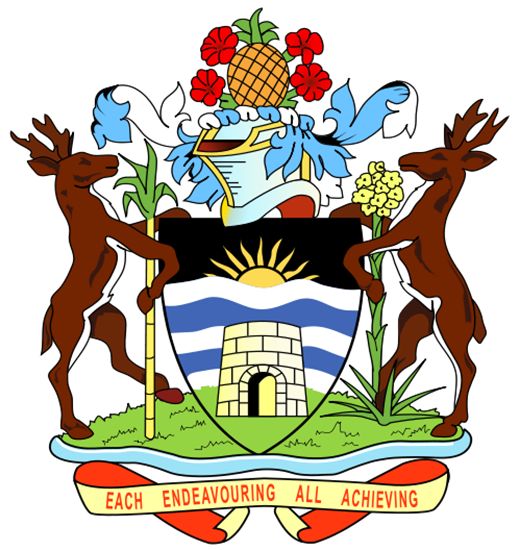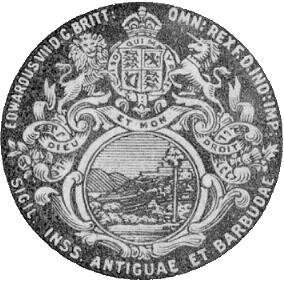National Arms of Antigua and Barbuda
| Heraldry of the World Civic heraldry of Antigua and Barbuda |
National Arms of Antigua and Barbuda
Origin/meaning:
These arms were officially granted on 16-02-1967.
The arms depict mainly the sugar industry, which is a major source of income for the islands. The tower is a sugar cane mill. A sugar cane plant is depicted on the left side, on the right side a cotton flower is shown. The helmet is also topped by four hibiscus flowers, as well as a pineapple, the third agricultural crop on the islands. The deer are a symbol for the island of Barbuda.
The Crown Colony of Antigua and Barbuda used a partially heraldic badge both on its seal and on the flags used by the colony - the Union Jack used by the Governor, the Blue Ensign used by Government vessels and the Red Ensign used by merchant vessels.
The wording on the seal named the Sovereign, so the wording was changed when a new King came to the throne. The version illustrated shows the seal under Edward VII, but the composition remained the same: the British royal arms appeared at the top of the design, and in the lower half was a circular landscape design representing the colony.
The landscape (a larger version of which is also shown) is unclear, but appears to portray a fortification.
The island was discovered by Christopher Columbus in 1493, who named it after a church in Seville. Colonised by English settlers in 1632, it at first grew tobacco, but in the later 17th century, sugar was found more profitable.
The island was part of the federated colony of the Leeward Islands until 1956, and between 1958 and '62 was part of the Federation of the West Indies. Under the West Indies Act, passed by the British Parliament in 1967, it became an Associated State and enjoys full internal autonomy
Literature : www.christian-siemer.de/wappen/amerika/antigua_barbuda.htm



